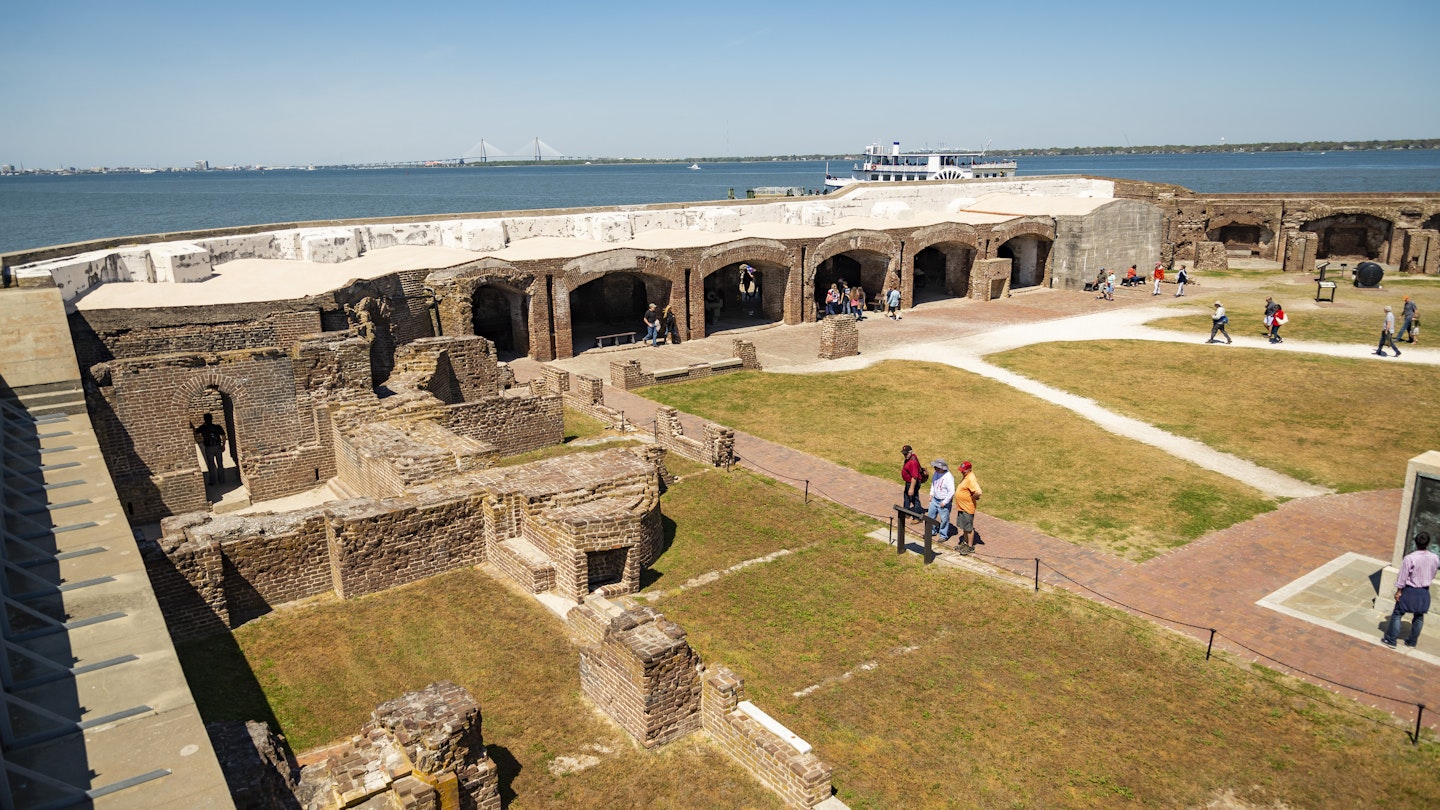Discover South Carolina’s National Parks
The Palmetto State boasts numerous sites that showcase pivotal moments in American history, alongside breathtaking natural landscapes. These attractions offer an opportunity to stroll along nature paths, listen to the birds, and admire nature’s beauty while delving into the Revolutionary War, Civil War, and Reconstruction era.
Admire the Majestic Trees of Congaree National Park
Experience the grandeur of ancient trees at South Carolina’s only scenic national park, Congaree. This park is home to primordial cypress trees, giant upland pines, and water tupelos, housing the highest concentration of “champion-size” trees (the largest of their species) in North America.
Be on the lookout for the impressive loblolly pine, towering over 170 feet tall. Additionally, the park protects the eastern United States’ largest tract of old-growth bottomland forest, which is periodically submerged throughout the year.
The best way to explore the trees and enjoy the park’s stunning scenery is via the 2.6-mile elevated Boardwalk Trail. You can paddle along the Congaree River, where its dark, tannic waters conceal turtles, frogs, and diverse aquatic life.
Visitors can bring their own canoe or kayak, or they may join a guided paddling tour led by a park ranger. Rentals are also available in Columbia, just a 30-minute drive away.
Feel the Revolution at Cowpens National Battlefield
If you believe the Revolutionary War did not impact the Southern states, think again. Among the several battles that occurred in South Carolina, Cowpens remains one of the most significant. This battle took place on January 17, 1781, near present-day Gaffney, in a wide-open woodland area known as “cowpens,” once utilized by early cattle drovers.
On that fateful day, General Daniel Morgan expertly positioned his Continental troops against Lieutenant Colonel Banastre Tarleton’s forces, resulting in over 1,000 casualties for the British compared to about 150 for the Americans. The park comprises a visitor center and offers a walking tour through the battlefield.
Consider Charleston’s Role in American History at Fort Sumter and Fort Moultrie National Historical Park
Two forts protect the entrance to Charleston’s harbor, serving as symbols of South Carolina’s roles in both the Civil War and the Revolutionary War. The more renowned of the two is Fort Sumter, where the Confederate Army fired upon the Union fort on April 12, 1861, marking the beginning of the Civil War.
This pivotal event led to 34 hours of bombardment, ultimately ending in a Union surrender. The Confederate forces subsequently occupied the fort, transforming it into a symbol of resistance, although it suffered extensive destruction from continuous Union shelling over the war’s course. Today, visitors can observe the remnants of the cannons and fortifications while learning about this crucial military installation.
Nearby, Fort Moultrie on Sullivan’s Island was instrumental in the early Patriot victories during the Revolutionary War, where Colonel William Moultrie’s South Carolinians successfully repelled a British assault.
Trace the Steps of Patriots at Kings Mountain National Military Park
During the Revolutionary War, Henry Jefferson termed it the “turn of the tide of success.” On October 7, 1780, American and Loyalist soldiers engaged in intense combat on this isolated ridge near the North Carolina border. Engaging in battle from tree to tree using rifles and bayonets, the rebels achieved the first American victory following the British invasion of Charleston.
The park preserves essential battle sites, with markers and monuments detailing the engagements. At the visitor center, guests can watch an introductory film, view exhibits, and find maps for exploring the walking trail weaving through the battlefield.
Learn About Plantation Life at the Charles Pinckney National Historic Site
Charles Pinckney, who divided his time between his family’s Charleston mansion and Snee Farm—an indigo and rice plantation—had a significant political role in the revolutionary cause, contributing numerous clauses to the U.S. Constitution. Inherited from his family in 1782, Snee Farm was supported by the labor of 58 enslaved individuals, as recorded in the 1810 census.
Today, the National Park Service has preserved 28 acres of Snee Farm as the Charles Pinckney National Historic Site, featuring ornamental gardens and live oaks. The visitor center, housed in an 1828 farmhouse, offers exhibits on the plantation’s history, the African people who were enslaved, and the plantation’s operations. Visitors can explore walking trails and archaeological displays, including unearthed relics from the plantation era.
Confront One of the U.S.’s Most Momentous Eras at Reconstruction Era National Historical Park
Many historians argue that Beaufort County, located in the Lowcountry, is the birthplace of Reconstruction—a tumultuous post-Civil War era (1861-1898) characterized by confronting the economic and social legacies of slavery. Established in 2019, Reconstruction Era National Historical Park aims to highlight nationally significant places and events throughout Beaufort County from this critical timeframe.
The park encompasses four sites in and around Beaufort, including the Penn Center on St. Helena Island, which was founded in 1862 as the first school in the South for formerly enslaved West Africans. Additionally, the historic Brick Baptist Church, built by enslaved individuals, continues to host active congregations today.
On New Year’s Day in 1863, Union Army General Rufus Saxton publicly announced the Emancipation Proclamation to a gathering of 3,000 Black soldiers and formerly enslaved people at Port Royal’s Camp Saxton. The Old Beaufort Firehouse in downtown Beaufort now serves as the visitor center for the park, providing an excellent point of entry for anyone interested in learning more.





